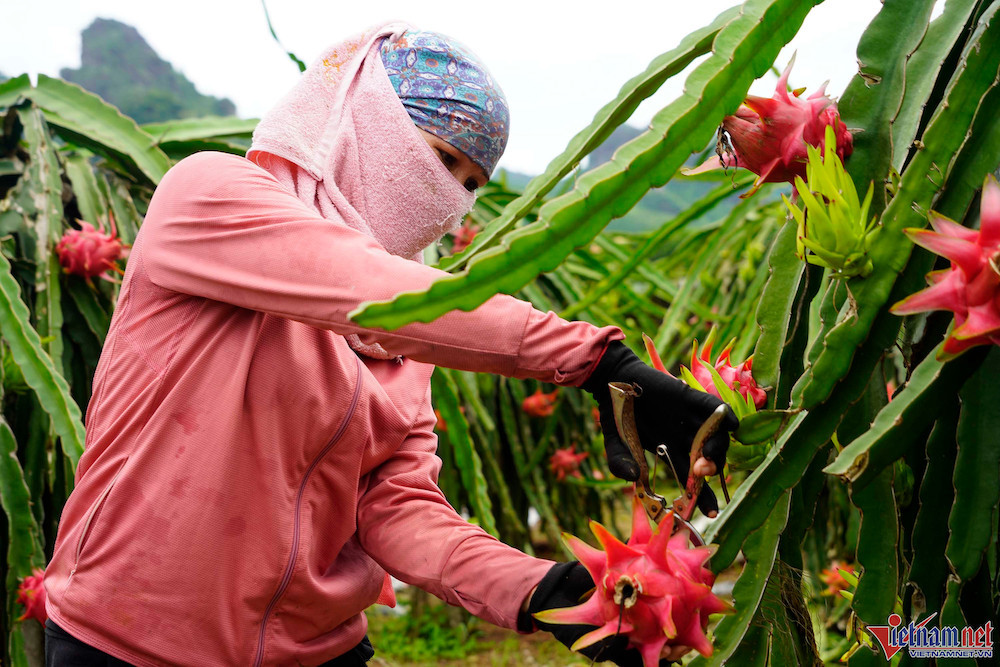In the conference “Sustainable Dragon Fruit Development in Vietnam”, organized on 29/9 by the Ministry of Agriculture and Rural Development and the United Nations Development Programme (UNDP), experts pointed out the limitations causing the billion-dollar dragon fruit industry to fall behind.
Mr. Nguyen Quoc Manh, Head of the Fruit and Industrial Crops Department, Plant Cultivation Directorate (Ministry of Agriculture and Rural Development), stated that, for a long time, Vietnam has always been number one in both cultivation area and export quantity of dragon fruit. However, since 2021, Vietnam has moved down to the second position in the world, after China.

Currently, Vietnam has 55,000 hectares of dragon fruit, with a production output of about 1.3 million tons/year. In contrast, China has 67,000 hectares of dragon fruit, with a production output of 1.6 million tons.
Also, according to Mr. Manh, the peak period for dragon fruit has passed. This billion-dollar agricultural product is showing a downward trend in both area and production. Specifically, while Vietnam had over 65,000 hectares of dragon fruit in 2020, by 2022, this number has decreased to 55,000 hectares (a reduction of nearly 10,000 hectares). Dragon fruit production in 2022 decreased by 110,000 tons compared to 2021.
The export value of dragon fruit also sharply decreased, from the peak of 1.27 billion USD in 2018 to about 663 million USD in 2022. The export value in the first eight months of this year was only around 350 million USD.
Conversely, in 2011, China only had 3,400 hectares of dragon fruit, but by 2021, it had 67,000 hectares, surpassing Vietnam.
In agreement with the data from the Ministry of Agriculture and Rural Development, Ms. Tran Thanh Binh, Head of the Department of Agricultural, Forestry and Fishery Imports and Exports, Import and Export Directorate (Ministry of Industry and Trade), pointed out the reasons causing Vietnamese dragon fruit to “retreat.”
Firstly, 80-85% of the annual dragon fruit production serves export needs, leaving only 15-20% for domestic consumption. Meanwhile, China is the primary consumer market, accounting for over 80% of the total dragon fruit export turnover. The sharp decrease in dragon fruit export is entirely due to reduced demand in the Chinese market.
Secondly, there has been a significant shift in the structure of fruit exports from Vietnam.
In 2021, dragon fruit accounted for 43% of the export structure, durian was 7.5%. By 2023, the proportion of dragon fruit had decreased to 17.7%, while durian rose to 46.9%.
This is another reason showing the influence of the Chinese market, as people switch from consuming dragon fruit to durian. Clearly, for a long time, dragon fruit exports have been highly dependent on the neighboring market.
Currently, Vietnamese dragon fruit faces fierce competition. China is boosting production, focusing on meeting domestic consumption needs, significantly impacting the export value of Vietnam’s dragon fruit.
According to the representative of the Import and Export Directorate, there is an immediate need to promote products, introduce the health benefits of dragon fruit, and stimulate domestic consumption. Dragon fruit needs to establish a brand like Lai Vung mango (Dong Thap) in the domestic market.
Mr. Nguyen Thanh Binh, Chairman of the Vietnam Fruit Association, suggested that the agricultural sector should focus on reorganizing dragon fruit production, going in-depth on the remaining area, and not expanding to new areas. At the same time, localities should not allow dragon fruit to be replaced by other crops.
According to him, it is necessary to create high-quality products, improve the competitiveness of Vietnamese dragon fruit by enhancing quality, ensuring safe products, reducing costs, and utilizing the periods of the year when China cannot produce to export.
Besides China, businesses need to find new markets for dragon fruit or diversify processed products from dragon fruit, meeting the needs of the US, Europe… These are places with a very high demand for processed products.
source : vietnamnet.vn
